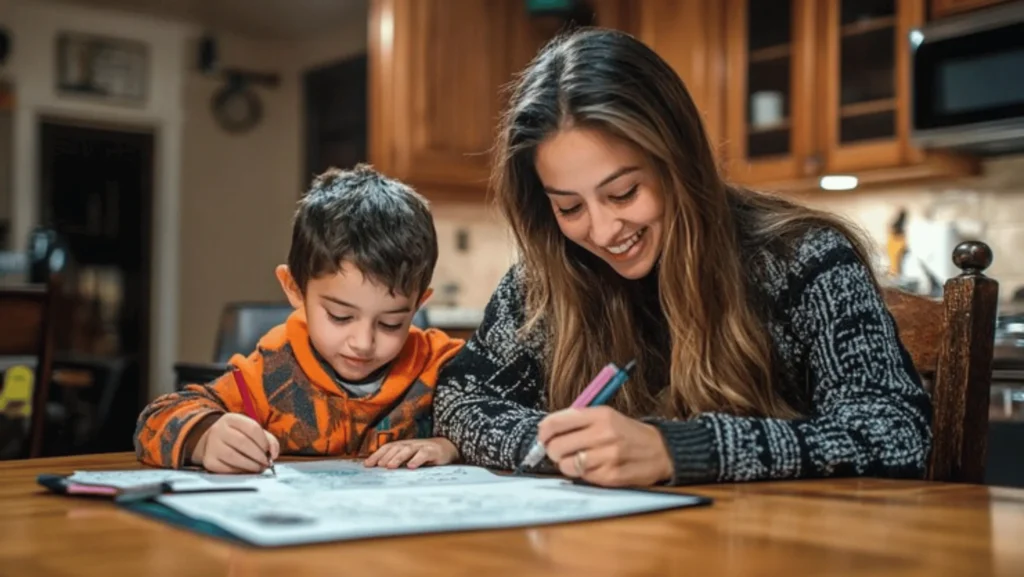By a Working Mom Who’s Been There
I still remember the day I officially became a homeschool mom. My son was five, and I had just gotten off a Zoom call for work when he looked up from his crayons and said, “Mommy, are we doing school today?” My heart sank. It was already 2 p.m., and all we’d managed that day was a half-hearted attempt at the alphabet and a snack break.
That’s when it hit me: homeschooling wasn’t going to magically fall into place. I had to be intentional, flexible, and most importantly—kind to myself.
If you’re a working mom diving into the world of homeschooling, first of all, let me say this: you are not alone. It’s a brave, messy, beautiful choice, and while it won’t always be easy, it will absolutely be worth it.
Here are the most important lessons I’ve learned in our homeschooling journey—along with practical tips, honest truths, and a whole lot of love.

1. Start Simple and Give Yourself Permission to Learn Too
When I first started homeschooling, I bought way too many curriculum packages, downloaded every printable on Pinterest, and tried to replicate a traditional classroom in our living room. Spoiler alert: it was overwhelming. My son wasn’t engaged, I was exhausted, and no one was having fun.
What worked instead:
I focused on the basics—reading, writing, and simple math. We read books together, practiced counting with snacks, and wrote grocery lists. I let curiosity guide our lessons. One week we learned about dinosaurs because he asked a question during breakfast. Another week, we explored the life cycle of butterflies after spotting one in the yard.
Tip:
Don’t be afraid to start small. You don’t need a perfect plan—you need a willing heart. It’s okay to learn as you go. In fact, that’s part of the beauty of homeschooling: you grow right alongside your child.
2. Time Management: The Key to Your Sanity
Balancing work and homeschooling is a daily puzzle. I’m not going to sugarcoat it—it’s hard. But it’s not impossible.
Here’s how I made it work:
- Create a loose but reliable schedule:
I split our day into blocks: morning learning time, independent play, lunchtime, quiet time (aka work time for me), and afternoon wrap-up. We didn’t follow it perfectly, but having a rhythm helped us both know what to expect. - Batch work when you can:
I saved focused tasks (like emails and meetings) for early mornings or nap/quiet time. I handled lighter tasks while sitting beside my son as he did a worksheet or painted. - Use weekends to prep:
I spent Sunday evenings planning the week ahead—printing materials, setting up activities, and jotting down a rough outline of what we’d cover.
Tip:
Don’t aim for perfection. Aim for progress. Some days you’ll feel like a superhero. Other days, it’s cereal for dinner and a documentary for “science class.” That’s okay.
3. Self-Care Isn’t Selfish—It’s Survival
I neglected myself during those first few months. I wore the same sweatshirt five days in a row, forgot what a hot cup of coffee tasted like, and felt like I was constantly giving and never receiving.
Then one day, after a full-on meltdown (mine, not my son’s), I realized something had to change.
I started waking up 30 minutes earlier to stretch, breathe, and sip coffee in peace. I started saying no to things that drained me and yes to things that filled me up—even if that meant watching a show after bedtime or sneaking chocolate in the pantry.
Tip:
Make a list of 5 simple things that help you feel human again. Mine include:
- Morning coffee in silence
- A short daily walk
- Journaling once a week
- Reading for pleasure
- Calling a friend
Put those things on your calendar like appointments. Because you matter, too.

4. Overcoming Guilt: The Silent Struggle
Working moms carry a unique kind of guilt. Are we working too much? Teaching enough? Giving enough attention? Too much screen time? Not enough structure?
I’ve wrestled with all of it.
Here’s the truth I’ve come to believe: Guilt is a sign that you care—but it doesn’t mean you’re failing.
When I feel guilty, I ask myself: Is this guilt based on truth or unrealistic expectations? More often than not, it’s the latter.
Tip:
Keep a “win list.” Each day, jot down one thing you and your child accomplished—big or small. It could be “read a whole book together” or “survived a tantrum with patience.” Celebrate it. You’re doing more than you realize.
5. Work-Life Balance: Blend, Don’t Battle
I used to chase the idea of balance as if it meant 50/50 every day. But balance, I’ve learned, is fluid. Some days, my work needs more attention. Other days, my son does.

And some days? We all just need a break.
What helped me the most was blending my roles instead of keeping them separate. If I had a deadline, I’d explain it to my son and let him “work” beside me with coloring or puzzles. If he was excited about a new topic, we’d turn it into a project I could share with coworkers as an example of learning through play.
Tip:
Get creative. Homeschooling doesn’t have to happen from 8 to 3. We often do lessons in the evenings or during car rides. Learning is everywhere—and so is flexibility.
6. Connect with a Support System (Even Online Ones)
Homeschooling can feel isolating, especially when you’re also juggling a job. But you don’t have to go it alone.
I joined a few Facebook groups, followed other homeschool moms on Instagram, and even scheduled virtual playdates. Just knowing someone else was dealing with the same struggles made a huge difference.
Tip:
Find your tribe—even if it’s virtual. Ask questions, share your wins and fails, and lift each other up.
7. Practical Homeschool Tips for Beginners
Here’s a roundup of quick, practical tips that have saved my sanity:
- Morning baskets: Fill a basket with books, puzzles, or flashcards to start the day calmly.
- Use real-life learning: Cooking = math. Gardening = science. Cleaning = life skills.
- Rotate toys and activities: Keeps things fresh without spending more.
- Audiobooks are gold: Great for quiet time and car rides.
- Keep a “boredom box”: Fill it with special toys, games, or crafts for when you need a work block.
Final Thoughts: Mama, You’re Doing Enough
If you’ve made it this far, you’re clearly invested. You care. And that, my friend, is the foundation of a beautiful homeschooling journey.
Yes, there will be messy days. There will be tears (from both of you). But there will also be giggles during science experiments, snuggles over storybooks, and moments when your child surprises you with something they’ve learned—and you’ll know that you helped make that happen.
You don’t have to be perfect. You just have to be present.
So, take a deep breath. Hug your kid. And remember this: you’ve got this.
Homeschooling isn’t about doing everything. It’s about doing what matters most—together.
